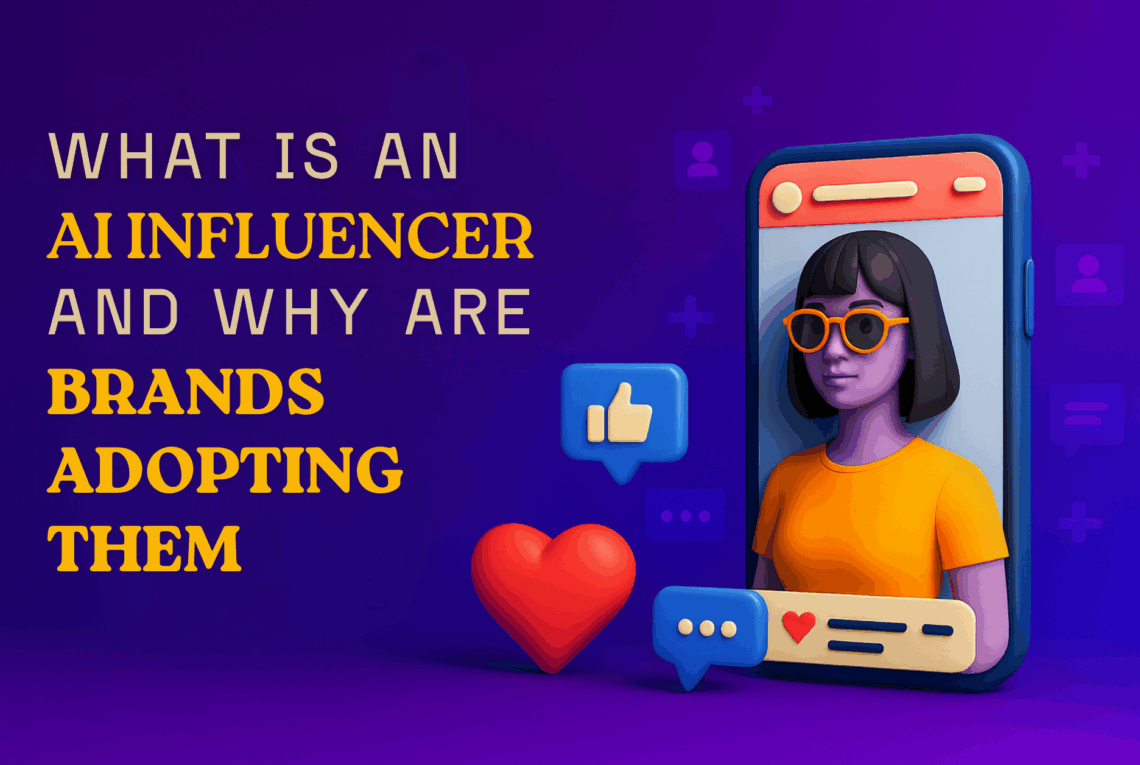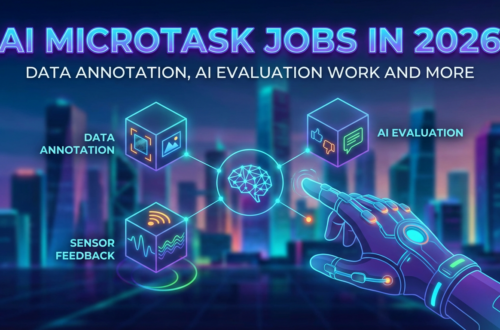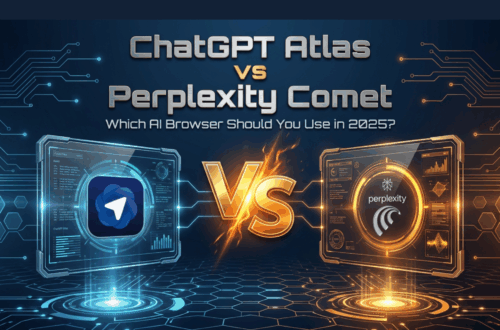The world of marketing is evolving faster than ever, and one of the most fascinating new trends is the rise of AI influencers. From Instagram feeds to TikTok videos, these digital personalities are captivating millions of followers worldwide, and the surprising part is, they aren’t even human.
India’s digital economy is going through one of its biggest transformations. With over 800 million internet users, 450 million social media users, and a rapidly growing creator economy valued at ₹3,000+ crore, influencer marketing has become a major force in shaping consumer behavior.
But a new trend is rising fast, AI influencers. These are not human celebrities, nor everyday content creators. They are virtual personalities created using artificial intelligence, complete with unique looks, voices, and personalities, who now have real fan bases and are partnering with Indian and global brands.
If you’ve come across Aaj Tak’s AI anchor “Sana” or Myntra’s virtual fashion assistants, you’ve already seen the future.
In this blog, we’ll break down what AI influencers are, why brands are embracing them, how you can create one, and how this futuristic trend is reshaping digital marketing. Whether you’re a freelancer, entrepreneur, marketer, or simply curious about the digital economy, this article will give you everything you need to know.
What is an AI Influencer?
An AI influencer (also called a virtual influencer or digital influencer) is not a human being, but a computer-generated personality created using technologies like artificial intelligence, 3D modeling, animation, and machine learning. Think of them as digital celebrities; they look, talk, and behave like real people on social media, yet their every move is scripted and controlled by creators.
Unlike traditional influencers, who are real individuals sharing their lifestyle or expertise, AI influencers are fictional characters brought to life through advanced technology. They are designed with unique personalities, styles, and even backstories, making them feel “real” to their audience. In fact, some are so hyper-realistic that followers don’t even realize they are engaging with an AI-generated persona until it’s revealed.
How They Work Behind the Scenes
- Design & Appearance: Creators use 3D modeling tools like Blender, Unreal Engine, or AI-driven design platforms like MidJourney and Stable Diffusion to craft their look. This can range from ultra-realistic human features to stylized cartoon-like avatars.
- Personality & Content: Large language models (like ChatGPT) help script posts, captions, and conversations. This gives the influencer a consistent “voice” and “tone.”
- Voice & Video: Tools like Murf AI or Synthesia generate natural-sounding voices in multiple languages, while AI video platforms animate them into short-form reels or YouTube content.
- Engagement: Advanced AI chatbots allow them to reply to comments and DMs in real time, making them feel more “alive” and interactive.
Why They’re Unique
The real charm of AI influencers lies in their flexibility and control. They:
- Never age, get tired, or take a break.
- Can be programmed to speak any language, making them perfect for India’s multi-lingual audience.
- Don’t carry risks of scandals or controversial opinions; everything they say or do is aligned with their brand image.
- Can experiment with fantastical looks or futuristic settings that human influencers cannot.
Real-World Examples
Globally, AI influencers like Lil Miquela (a Brazilian-American virtual fashion icon with 3M+ followers) and Shudu (the “world’s first digital supermodel”) have already partnered with brands like Prada, Dior, and Samsung. In Japan, Imma, with her iconic pink bob, has become a cultural sensation.
Closer home in India, we’ve seen the rise of AI anchor Sana by Aaj Tak, a digital personality that reads news bulletins just like a human journalist. E-commerce giants like Myntra and Flipkart are experimenting with AI-powered virtual shopping assistants who recommend fashion looks in real time. This shows that AI influencers are not just a global experiment; they are already part of India’s digital ecosystem.
Why Audiences Follow Them
At first glance, the idea of following a “fake” person might seem odd. But in reality, most audiences don’t even realize they’re fake at all. Many AI influencers are designed with such hyper-realistic features, gestures, and personalities that they are often indistinguishable from human influencers. This initial “illusion of reality” plays a huge role in why they gain followers so quickly.
Once audiences discover they are AI-generated, the fascination often grows stronger, and people are curious about the blend of technology and creativity behind the character.
Key reasons why followers are drawn to AI influencers:
- Hyper-Realism & Believability – Many AI influencers look so authentic that people engage with them as if they were real humans. This realism reduces initial skepticism and boosts adoption.
- Novelty & Creativity – They bring futuristic and imaginative storytelling to life, doing things human influencers cannot, like blending fashion shoots with sci-fi worlds.
- Consistency – No mood swings, no off-brand comments, no controversies, just polished, brand-safe content every time.
- Relatability – Despite being digital, they often mirror human emotions, lifestyles, and cultural behaviors, from celebrating Diwali to trying the latest street food trend.
- Engagement – AI influencers can reply instantly to thousands of followers using AI-driven chatbots, creating the illusion of direct, personal connection.
💡 In short: An AI influencer is a fusion of art, hyper-realism, storytelling, and technology, designed to behave like the social media personalities we already love, but with endless scalability, control, and creative potential.
Popular AI Influencers in 2025
- Lil Miquela (@lilmiquela) – One of the first famous AI influencers, with millions of Instagram followers.
- Shudu (@shudu.gram) – Dubbed the “world’s first digital supermodel.”
- Imma (@imma.gram) – A Japanese virtual influencer known for her pink bob haircut.
- Noonoouri (@noonoouri) – A fashion-focused AI influencer who collaborates with luxury brands.
💡 2025 Update: AI influencers are no longer just Instagram models. They are appearing in TikTok challenges, YouTube tutorials, and even live-stream shopping platforms powered by real-time AI avatars.
The Role of AI Influencers in Marketing
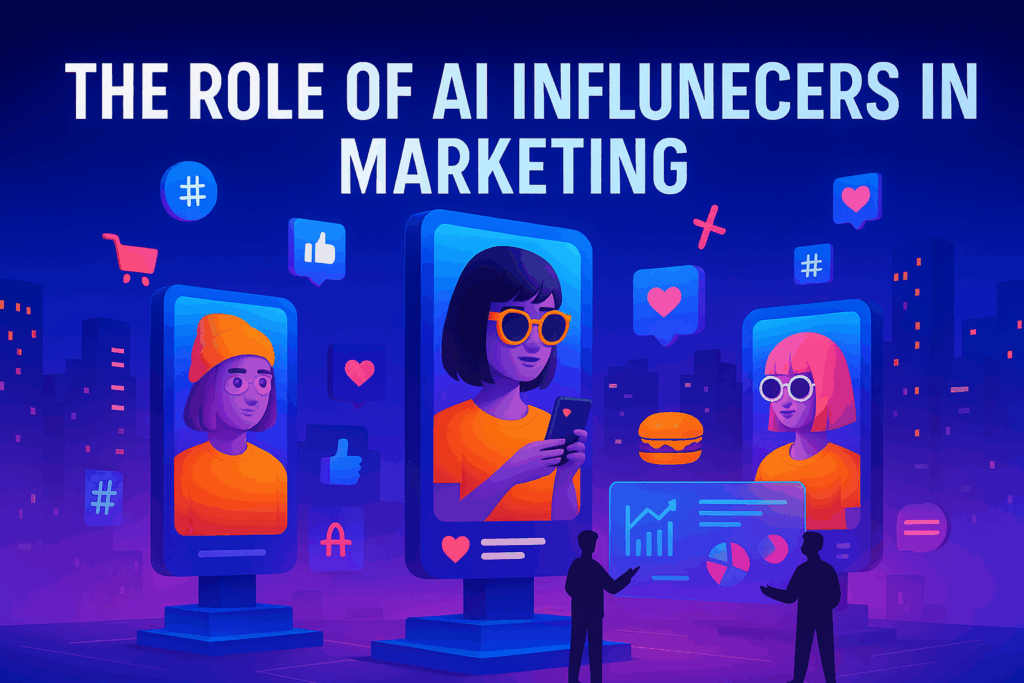
Influencer marketing has already transformed how brands reach their audiences, but the rise of AI influencers is taking it to the next level. With consumers spending more time online and demanding fresh, engaging content, brands are realizing that virtual influencers can be powerful brand ambassadors.
Far from being just a passing trend, AI influencers are proving to be strategic marketing assets. They combine the creativity of digital design with the precision of artificial intelligence, offering brands control, consistency, and cost-effectiveness at a scale human influencers simply cannot match.
Why Brands Are Turning to AI Influencers
- Cost-Effective in the Long Run
Hiring top human influencers in India, whether a Bollywood celebrity, a cricketer, or a popular Instagram creator, can cost lakhs or even crores per campaign. AI influencers, on the other hand, require an upfront investment in design and branding but can then be used indefinitely without ongoing negotiation fees. For startups and D2C brands operating on lean budgets, this makes AI influencers extremely attractive. - Full Creative Control
Human influencers bring individuality, but that also means unpredictability. A tweet taken out of context or a personal controversy can derail a campaign. With AI influencers, brands have 100% control over every word, expression, and gesture. They can decide the influencer’s tone, personality, and even wardrobe, ensuring a perfect fit for the campaign’s message. - Global and Local Reach
An AI influencer is not bound by geography. They can speak English for global audiences, Hindi for Tier-1 metros, Tamil or Telugu for South India, and Bengali or Marathi for regional campaigns; all without needing multiple ambassadors. This flexibility makes them ideal for India’s multilingual consumer base as well as international markets. - Consistency and Longevity
Unlike humans, AI influencers don’t age, lose popularity, or “burn out.” They don’t take vacations or switch to competitors. They can maintain the same brand image and personality for years, creating consistency across long-term campaigns. - Endless Creativity
AI influencers can exist in worlds that human influencers cannot. They can promote a cricket brand from inside a stadium simulation, model sarees while floating in space, or celebrate Diwali with futuristic holographic visuals. For brands that want to push creative boundaries, this opens new storytelling possibilities.
Case Studies: How Brands Are Using AI Influencers
- Prada x Lil Miquela
Prada collaborated with Lil Miquela, one of the world’s most famous AI influencers, to launch fashion campaigns that blurred the line between reality and digital art. The campaign was celebrated for being innovative, futuristic, and culturally relevant. - Samsung’s Virtual Characters
Samsung has experimented with AI avatars in product launches, using them as digital presenters and guides for tech-savvy audiences. These characters explain features, host events, and bring a futuristic appeal to campaigns. - Coca-Cola’s Interactive AI Ads
Coca-Cola tested AI avatars in interactive ad campaigns that engaged audiences in gamified storytelling, creating a deeper brand connection. - IPL Teams are exploring AI mascots and digital commentators to create next-level fan engagement.
- Zomato & Swiggy are experimenting with AI-driven avatars for food promotions, enhancing engagement on Instagram reels and ads.
✨ In summary: AI influencers are becoming indispensable to marketing because they offer creativity, control, and cost-efficiency that human influencers can’t always provide. And in India, with its massive digital audience, multilingual diversity, and booming startup culture, their role will only grow bigger in the years ahead.
How to Create an AI Influencer and Earn Money
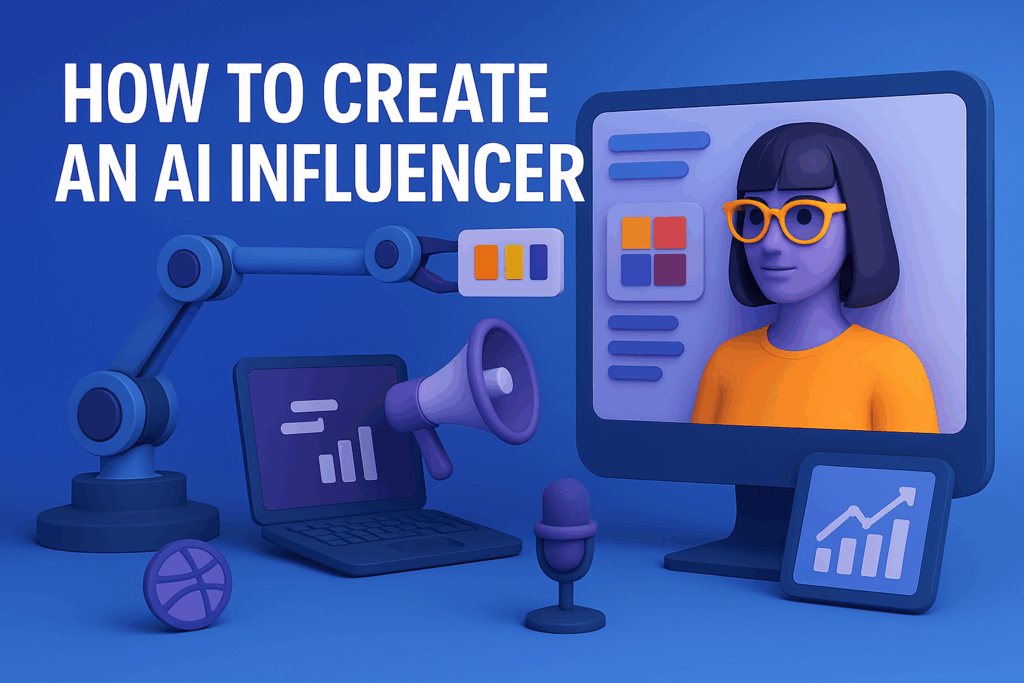
One of the most exciting aspects of AI influencers is that you don’t need to be a multinational brand or a Bollywood-level celebrity to create one. With today’s tools, even freelancers, startups, and small businesses in India can design their own AI influencers, grow them on social platforms, and eventually monetize them like human creators do.
In fact, much like how YouTubers and Instagram creators built empires a decade ago, AI influencer creators are poised to become the next wave of digital entrepreneurs.
Here’s a step-by-step blueprint:
1. Choose a Niche & Personality
Your AI influencer is essentially a digital brand personality, so start with clarity:
- Pick a niche: Fashion, tech, gaming, lifestyle, education, travel, food, or even hyper-local content (like Indian street food or cricket analysis).
- Define personality traits: Funny, quirky, aspirational, futuristic, minimalist, or activist. For example, an AI influencer in India could be a college-going, Hindi-speaking fashionista or a tech-savvy gamer who explains gadgets in Hinglish.
- Backstory matters: Just like human influencers share personal stories, AI influencers need a backstory. Audiences engage better if they know who this “character” is, even if it’s fictional.
💡 Pro tip for India: Consider regional relevance. An AI influencer who celebrates Diwali, wears ethnic outfits, and speaks in Tamil during Pongal campaigns will instantly connect with Indian audiences.
2. Design the Avatar
This is where technology brings your influencer to life. You can go ultra-realistic (human-like) or stylized (anime/cartoon look) depending on your target audience.
Popular Tools:
- 3D Design Platforms: Blender, Unreal Engine, Maya – great for realism, but require skills.
- AI-Powered Platforms: Soul Machines, Ready Player Me, or Zepeto for easy, customizable avatars.
- Generative AI: MidJourney, Stable Diffusion for creating stunning visuals of your influencer in different outfits, poses, or cultural setups.
3. Create Engaging Content
Content is the lifeblood of an influencer. For AI influencers, the advantage is that you can produce highly polished, brand-safe content consistently.
- Images: MidJourney, Stable Diffusion to generate posts for Instagram.
- Videos & Reels: Synthesia, D-ID, and Pika Labs for creating short-form content that works on Instagram, YouTube Shorts, Moj, and Josh (India’s TikTok alternatives).
- Voiceovers: Murf AI, ElevenLabs for multilingual voices. Imagine your AI influencer doing a product review in Hindi and then switching to Tamil for another market.
- Captions & Scripts: ChatGPT or Jasper AI to write trendy captions, hashtags, and even humorous comment replies.
💡 Indian opportunity: Short-form video is huge. If your AI influencer posts 30-second reels about IPL updates, Bollywood fashion looks, or Indian snacks, virality can happen quickly.
4. Grow an Audience
Creating content is just the start; you need to grow your influencer’s brand presence.
- Start with Social Platforms: Instagram, YouTube Shorts, Moj, and Josh. These are where Indian audiences spend the most time.
- Collaborate with Humans: Pair your AI influencer with micro-influencers for relatability. For example, a human food blogger could “interview” your AI influencer about favorite Indian dishes.
- Festival Tie-ins: In India, festivals are peak engagement moments. An AI influencer dressed for Diwali, Eid, or Holi can easily trend if positioned well.
5. Monetization Strategies
Once you’ve built a following, it’s time to monetize. AI influencers can earn money just like human ones:
- Brand Collaborations – Partner with brands (Myntra, Nykaa, Sugar, Mamaearth, Zomato, Swiggy). They pay for sponsored posts and reels.
- Affiliate Marketing – Promote products through Flipkart and Amazon affiliate links, earning commissions per sale.
- Merchandise & NFTs – Sell digital collectibles like AI-designed artwork, AR filters, or branded merchandise.
- Subscription Models – Offer exclusive “behind-the-scenes” content via Patreon-style platforms or YouTube Memberships.
- Licensing – Rent your AI influencer out to companies as a digital brand ambassador.
💡 Real-world angle: Imagine an AI influencer in a saree doing product placements for Tanishq or FabIndia, or a cricket-themed avatar promoting apps like Dream11. These are lucrative Indian niches waiting to be tapped.
🌟 The Future of the AI Creator Economy
Just like YouTubers went from “hobbyists” to millionaires, the same shift is starting with AI influencers. Within the next 3–5 years, India could see:
- Regional AI Influencers becoming household names (a Marathi foodie, a Tamil techie, a Punjabi fashionista).
- AI Influencer Agencies offering brands ready-to-use digital personalities.
- Freelancers dominating this niche by providing services like AI avatar design, reel creation, and influencer management.
In other words: AI influencers are the next big freelancing opportunity in India’s digital economy.
✨ In summary: Creating an AI influencer isn’t just for global giants. With the right niche, design, and content strategy, any freelancer or small business in India can build one, grow a following, and turn it into a steady revenue stream. The tools are here, the audience is ready, and the timing couldn’t be better.
How Brands are Using AI Influencers to Market Smartly
AI influencers are no longer just experimental projects for brands; they are becoming strategic tools in digital marketing campaigns. From luxury fashion houses to food delivery apps, companies are realizing that AI-driven personalities can offer scale, creativity, and control that human influencers cannot.
Instead of seeing AI influencers as gimmicks, smart brands are integrating them into multi-channel marketing strategies to connect with diverse audiences across geographies and demographics.
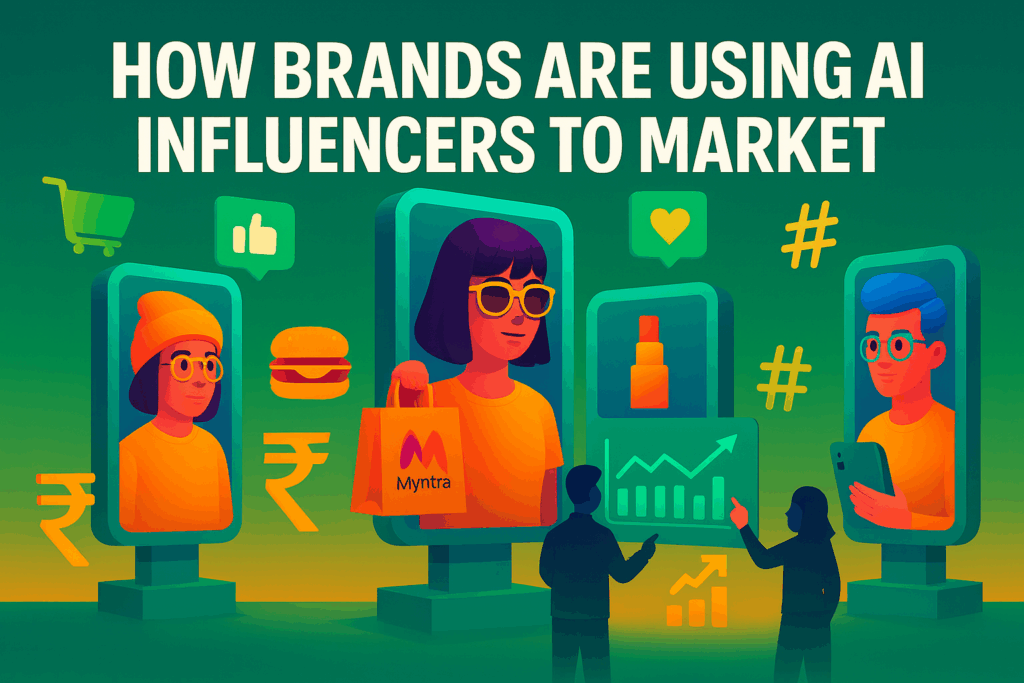
Smart Marketing Tactics
- Personalized Engagement at Scale
Traditional influencers can only respond to a limited number of comments and DMs. AI influencers, powered by chatbots and natural language processing, can reply to thousands of fans simultaneously, answering queries, recommending products, or simply building rapport. This creates the illusion of personal interaction, something audiences deeply value.
- Example: An AI influencer promoting a skincare brand can instantly answer thousands of questions like, “Is this good for oily skin?” in multiple languages.
- Localized Campaigns Across Languages
One of the strongest advantages of AI influencers is multilingual flexibility. A single AI influencer can post in English on Instagram, speak Hindi for YouTube Shorts, and use Tamil or Telugu on Moj or Josh.
- For India: This means brands can run pan-India campaigns without hiring multiple regional influencers, significantly lowering costs while boosting relatability.
- Cost Reduction & Efficiency
While top-tier influencers or celebrities charge massive fees per campaign, AI influencers are a one-time investment. Once created, they can be reused in endless campaigns without additional costs for appearance fees, travel, or management. For Indian D2C brands or startups, this means high ROI without burning marketing budgets. - Creative Storytelling Beyond Human Limits
AI influencers can exist in fantasy environments or futuristic worlds, something humans can’t replicate. They can wear 10 different outfits in 10 seconds, appear in space or inside a cricket stadium, and even collaborate with fans in interactive campaigns. This opens limitless storytelling opportunities.
Risks & Ethical Considerations
As exciting as they are, AI influencers come with challenges brands must address:
- Transparency – Should audiences be told that an influencer is AI-generated? Many experts argue disclosure builds long-term trust, while others use mystery as part of the campaign’s appeal.
- Authenticity – Audiences often value “real human experiences.” If overused, AI influencers risk being seen as too artificial and losing emotional connection.
- Cultural Sensitivity – In a diverse country like India, brands must ensure AI influencers respect traditions, attire, festivals, and languages. A misstep could quickly lead to backlash.
- Over-Saturation – If every brand creates AI influencers, the novelty factor could fade. Maintaining uniqueness will be key.
Successful Campaign Examples
- Balmain’s “Virtual Army”
Luxury fashion brand Balmain launched a digital-only model lineup, showcasing diversity and inclusivity. This allowed the brand to experiment with futuristic visuals and set itself apart from competitors. - IKEA Japan
IKEA introduced an AI character who gave personalized product recommendations based on customer queries. This improved engagement and positioned IKEA as a tech-savvy, customer-first brand. - KFC China – Virtual Colonel Sanders
KFC reimagined its founder as a virtual influencer who appeared in ads, livestreams, and social content. The quirky campaign attracted younger audiences and created buzz across social platforms.
✨ In summary: Smart brands are using AI influencers not just to save costs, but to redefine audience engagement. With personalization, scalability, and creative storytelling, AI influencers are quickly moving from novelty to mainstream marketing strategy, and in India’s multilingual, cost-sensitive, festival-driven ecosystem, their potential is even greater.
Future of AI Influencers in Marketing
The rise of AI influencers is still in its early days, but their trajectory is clear; they will become a permanent and powerful force in digital marketing. As technology advances, these virtual personalities will evolve from being just social media curiosities into fully integrated brand assets that drive sales, customer engagement, and even community building.
Predictions for 2025 & Beyond
- Integration with AR/VR and the Metaverse
The future of online shopping and brand engagement lies in immersive experiences. Imagine logging into Myntra’s virtual store during Diwali sales and being guided by an AI stylist who helps you try on sarees, kurtas, or sneakers in real-time AR. Or imagine walking into a VR showroom for Samsung where an AI influencer explains new features as if you were in a physical store.
- This level of personalization will make AI influencers the face of metaverse commerce, bridging e-commerce and immersive marketing.
- Real-Time Livestreaming with AI Influencers
Today, livestream shopping is a massive trend in China and gaining traction in India via Flipkart Live and Amazon MiniTV. Soon, AI influencers will be able to host live Q&A sessions, powered by natural language models, answering customer queries in Hindi, English, or regional languages on the spot.
- Picture an AI influencer doing a live gadget review in Hinglish, instantly replying to “Bhai, battery backup kitna hai?” in a way that feels authentic.
- Hybrid Collaborations: Human + AI Influencers
Rather than replacing human influencers, the future is about collaboration. Brands will bring together Bollywood celebrities, cricketers, and AI influencers in joint campaigns.
- Example: Imagine Virat Kohli promoting a sports brand alongside an AI fitness influencer who demonstrates workouts in real-time. This kind of hybrid storytelling blends human authenticity with AI’s scalability and creativity.
- AI Brand Ambassadors for Every Company
Just as every major brand today has a logo, tagline, or mascot, in the future, AI influencers may become the “digital face” of every brand.
- Banks may deploy AI influencers as friendly financial advisors who explain loans or credit cards in simple language.
- EdTech firms could use AI teachers who engage with students in regional dialects.
- Healthcare brands might use AI doctors or wellness coaches to explain treatments.
- Hyper-Personalized Marketing
AI influencers of the future won’t just be broad personalities; they’ll be tailored for individuals. With AI, a user in Mumbai could interact with a different version of the same influencer than a user in Chennai, with content that resonates with their culture, language, and lifestyle.
Impact on Human Influencers
The rise of AI influencers doesn’t mean the end of human influencers, but it will reshape the influencer landscape.
- Competition: Human influencers will face pressure to stay authentic, since AI influencers will dominate in consistency, scalability, and cost-effectiveness.
- Collaborations: Expect more partnerships between humans and AI. A food vlogger could cook a recipe while their AI co-host “reviews” the dish, creating unique storytelling formats.
- New Roles for Humans: Instead of being replaced, many human influencers may become creators, managers, or strategists behind AI influencers, designing and scripting these virtual personalities.
- Cultural Relevance: Human influencers will still dominate spaces requiring authenticity, emotions, and lived experiences (e.g., social causes, personal journeys).
💡 In India, where audiences value cultural resonance and relatability, human influencers will remain strong. But AI influencers will be adopted by brands seeking scale and multilingual reach, creating a hybrid ecosystem of real + virtual creators.
Conclusion
AI influencers are no longer just futuristic experiments; they are actively reshaping influencer marketing today. What began as a novelty in global fashion and luxury campaigns has now grown into a serious, mainstream strategy for brands of all sizes, including those in India’s booming digital economy.
For brands, AI influencers provide:
- A cost-effective alternative to traditional celebrity endorsements.
- A scalable, multilingual solution for India’s diverse consumer base.
- A risk-free partner that stays on-brand, 24/7.
For freelancers, creators, and entrepreneurs, this is a golden window of opportunity. With today’s accessible tools – MidJourney, Murf AI, D-ID, Pika Labs, you don’t need a Hollywood budget to:
- Create your own AI influencer from scratch.
- Build niche communities on Instagram, YouTube Shorts, Moj, or Josh.
- Earn through brand partnerships, affiliate marketing, and digital collectibles.
- Offer AI influencer creation services to Indian startups and D2C brands eager to stand out.
As India pushes toward becoming a $200+ billion digital-first economy, AI influencers will play a pivotal role in shaping consumer engagement, brand storytelling, and the creator ecosystem.
The line between real and virtual is fading fast. The question is no longer if AI influencers will dominate, but how soon your brand or your freelancing career will embrace them.
✨ For brands, the time to experiment is now.
✨ For freelancers, the time to upskill and grab this opportunity is today.
🚀 Start building your first AI influencer today and be part of the next big wave in India’s creator economy.
💡 Ready to Create Your Own AI Influencer?
AI influencers are the future of marketing, and the best time to start is now. Whether you’re a brand looking to scale campaigns or a creator ready to build your first digital personality, you don’t have to do it alone.
👉 On Truelancer, you can hire top-rated freelancers skilled in:
- AI avatar design & 3D modeling
- AI video & reel creation (Synthesia, D-ID, Pika Labs)
- Voiceovers in English & Indian languages (Murf AI, ElevenLabs)
- Social media growth & influencer management
✨ Find the right freelancer today and bring your AI influencer idea to life.
👉 Hire Expert AI Creators on Truelancer
FAQs About AI Influencers
Q1. What is an AI influencer, and how is it different from a virtual influencer?
An AI influencer is a computer-generated personality powered by artificial intelligence, designed to act like a social media influencer. The term “virtual influencer” is broader; it can include any digital persona, whether AI-driven or manually animated. The difference is that AI influencers use machine learning, chatbots, and automation to interact with audiences in real time, making them more dynamic and scalable.
Q2. How much does it cost to create an AI influencer in India or globally?
The cost depends on the complexity:
- Basic AI influencer (using affordable tools like MidJourney, Ready Player Me, D-ID): can cost under ₹50,000 – ₹1,00,000 to launch.
- Advanced 3D-modelled influencer (with hyper-realistic design, branding, and AI integration): can cost ₹5–20 lakhs or more.
Globally, big brands invest hundreds of thousands of dollars in their AI influencers, but freelancers and startups can begin with budget-friendly options.
Q3. Can freelancers really earn money by creating AI influencers?
Yes! Freelancers in India and worldwide are already earning through:
- Brand Collaborations: Sponsorships with startups, D2C brands, and even local businesses.
- Affiliate Marketing: Promoting Flipkart, Amazon India, or global affiliate links.
- Digital Collectibles: Selling NFTs, AR filters, or AI-generated art linked to their influencer.
- Freelance Services: Offering avatar design, AI video creation, and influencer management on platforms like Truelancer.
💡 In fact, “AI influencer creation services” is becoming a new freelancing niche in India’s digital economy.
Q4. Do audiences actually trust AI influencers?
Yes, especially younger demographics like Gen Z and Gen Alpha, who are already comfortable with digital avatars in gaming, anime, and AR. Research shows audiences often find AI influencers:
- Entertaining (futuristic, creative content).
- Reliable (no scandals or off-brand opinions).
- Relatable (when programmed with cultural relevance, like celebrating Diwali or speaking in Hinglish).
However, transparency is critical. Brands that disclose an influencer is AI-driven tend to build more long-term trust.
Q5. Are AI influencers replacing human influencers in marketing?
Not completely. AI influencers are not here to replace human influencers but to complement them. Many campaigns now feature hybrid collaborations, where a human influencer partners with an AI personality—blending human relatability with AI’s scalability.
- For example, a Bollywood actor could endorse a product alongside a futuristic AI influencer in a campaign.
- This creates novelty and stronger brand engagement.
Q6. Which industries benefit most from AI influencer marketing?
Industries that are already content-driven and digital-first see the fastest adoption:
- Fashion & Beauty – Brands like Myntra, Nykaa, and Gucci use AI influencers for styling campaigns.
- Technology & Gadgets – Samsung and Indian D2C tech startups are experimenting with AI product explainers.
- Food & Lifestyle – Zomato and Swiggy are testing AI avatars for food promotions.
- Education (EdTech) – AI teachers and study influencers are gaining traction in India’s booming edtech sector.
- E-commerce – Flipkart, Amazon, and Ajio are integrating AI avatars as shopping assistants.
But the potential goes beyond these industries, almost any brand with a digital presence can benefit.
Q7. What is the future of AI influencers in marketing?
The future is incredibly promising. Expect:
- Metaverse Integration – AI influencers guiding shopping in VR/AR stores.
- Real-Time Livestreams – Hosting interactive Q&As during Flipkart Live or Amazon MiniTV sales.
- Hyper-Personalization – One influencer offering different versions for each region in India (Hindi, Tamil, Bengali, etc.).
- AI Brand Ambassadors – Every major company having its own always-available digital spokesperson.
In India specifically, AI influencers will likely grow fastest in fashion, edtech, fintech, and cricket-related marketing, where scale and cultural reach are essential.
Q8. How can I start building my own AI influencer today?
You can get started with:
Content Writing & Storytelling – ChatGPT or Jasper AI.
Once you’ve created your influencer, grow them on Instagram, YouTube Shorts, Moj, or Josh. As your audience grows, monetize through sponsorships, affiliates, and brand deals.
Avatar Design – Tools like MidJourney, Ready Player Me.
AI Videos & Reels – Pika Labs, Synthesia, D-ID.
Voices in Indian Languages – Murf AI, ElevenLabs.

